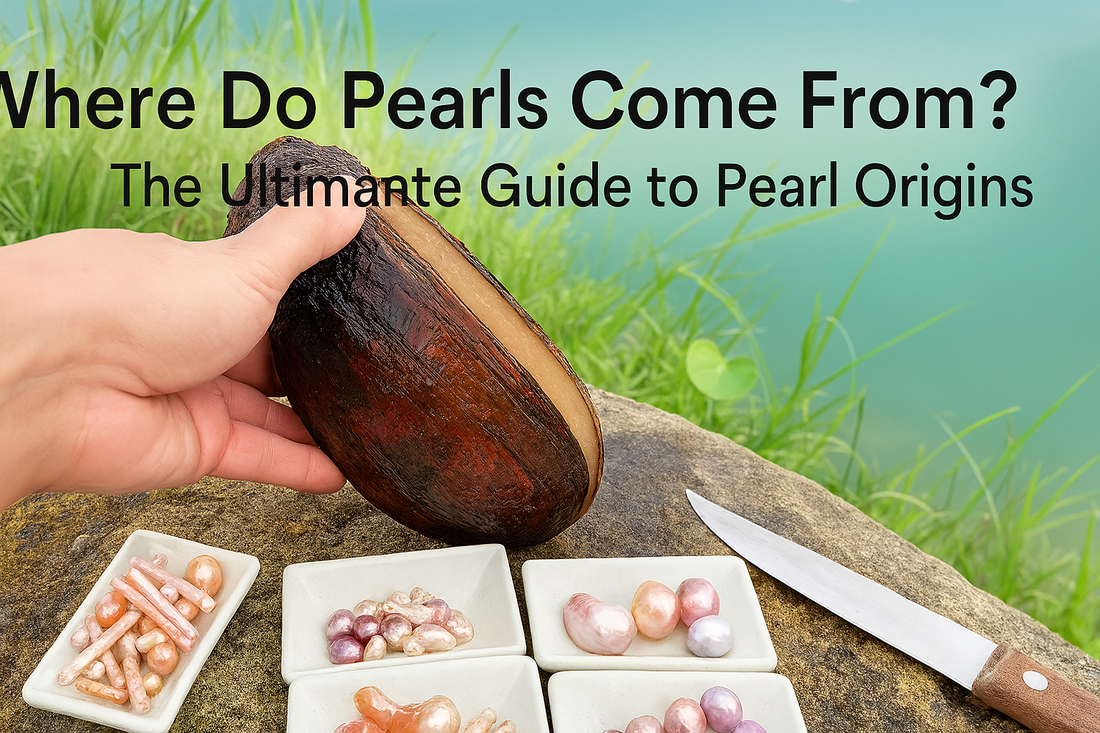Where Do Pearls Come From? The Ultimate Guide to Pearl Origins and Formation

Introduction
Where do pearls come from? This fascinating question has captivated humanity for centuries, and the answer is more magical than you might imagine! Pearls originate from living mollusks - primarily oysters and mussels - in a remarkable process that transforms ocean irritants into lustrous treasures. Unlike other gemstones that form deep within the Earth's crust, pearls are organic gems created by marine life through a natural defense mechanism.
When a foreign particle enters an oyster's shell, the mollusk secretes layers of nacre (pronounced "NAY-ker") around the irritant to protect itself. This nacre, also known as mother-of-pearl, creates the pearl's signature iridescent shine and smooth texture. The process can take anywhere from two to seven years, making each pearl a testament to nature's patience and artistry.
Today's pearl industry encompasses both natural and cultured varieties, with the latter accounting for over 95% of the market. From the depths of Tahitian lagoons to Japanese coastal waters, pearls continue their journey from ocean floor to elegant pearl bags and jewelry pieces. Understanding where pearls come from helps us appreciate these oceanic gems that have adorned royalty, inspired artists, and now grace our modern accessories with timeless elegance. 💎
Chapter 1: The Natural Birth of Pearls in Ocean Waters
The story of where pearls come from begins in the mysterious depths of our oceans, where ancient mollusks have been creating these natural masterpieces for millions of years. Natural pearls form through a completely organic process that showcases nature's incredible ability to transform adversity into beauty.
When we explore where pearls come from in their natural state, we discover that saltwater oysters, particularly the Pinctada species, are the primary creators of the world's most valuable pearls. These remarkable creatures live in specific ocean environments where temperature, salinity, and nutrient levels create perfect conditions for pearl formation.Don't hesitate to purchase yours here
The process begins when microscopic organisms, sand particles, or other foreign substances breach the oyster's protective shell. In response, the mollusk activates its defense mechanism, secreting nacre in thin, translucent layers around the irritant. This nacre consists of thousands of hexagonal crystals that reflect light in multiple directions, creating the pearl's characteristic luster and iridescence.
Natural pearls are incredibly rare, with only one in every 10,000 wild oysters producing a gem-quality specimen. This rarity explains why natural pearls have historically been more valuable than gold, and why they were once reserved exclusively for royalty and the wealthy elite. The famous La Peregrina pearl, discovered in the 16th century, exemplifies the extraordinary value placed on these natural ocean treasures.
The geographic distribution of where pearls come from naturally spans across tropical and subtropical waters worldwide. The Persian Gulf has been renowned for its natural pearls for over 4,000 years, while the Red Sea, Caribbean waters, and the coasts of Australia and Myanmar also produce exceptional specimens. Each region's unique environmental conditions contribute to distinct characteristics in color, luster, and size.
Climate change and ocean pollution have significantly impacted where pearls come from naturally, making wild pearl diving increasingly rare and regulated. Today, most natural pearl harvesting occurs under strict conservation guidelines, ensuring that these precious ecosystems remain protected for future generations while still allowing us to appreciate these incredible gifts from the sea.

Chapter 2: The Rev![]() olutionary World of Cultured Pearl Farming
olutionary World of Cultured Pearl Farming
- Cultured pearl farming revolutionized our understanding of where pearls come from by allowing humans to guide the natural process while maintaining the organic beauty of these oceanic gems.
- The technique was pioneered by Mikimoto Kōkichi in Japan during the 1890s, fundamentally changing how we answer the question "where do pearls come from" in the modern era.
- Cultured pearls begin their journey in carefully managed pearl farms where oysters are raised in controlled marine environments that optimize growth conditions.
- The process starts with nucleation, where skilled technicians carefully insert a small bead (usually made from Mississippi river mussel shell) and a piece of donor oyster tissue into the host mollusk.
- Akoya pearls, primarily cultivated in Japan, represent the classic white cultured pearl that most people envision when considering where pearls come from in contemporary jewelry.
- Tahitian pearls, grown in French Polynesia's pristine lagoons, showcase how where pearls come from influences their distinctive dark colors ranging from peacock green to deep black.
- South Sea pearls, cultivated in Australia, Indonesia, and the Philippines, demonstrate how where pearls come from affects size, with these specimens often exceeding 15mm in diameter.
- Freshwater pearls, primarily farmed in China's rivers and lakes, expand our understanding of where pearls come from beyond ocean environments, offering affordable alternatives in various shapes and colors.
- The pearl farming process requires 2-7 years of careful monitoring, water quality management, and protection from predators and storms.
- Modern pearl farms employ sustainable practices, ensuring that where pearls come from doesn't negatively impact marine ecosystems while meeting growing global demand.
- Quality control in cultured pearl production involves regular health checks of oysters, optimal spacing for growth, and careful timing of harvest seasons.
-
Cultured pearls now account for over 95% of the global pearl market, making these ocean treasures accessible to a broader audience while maintaining their natural beauty and formation process.

Chapter 3: Geographic Pearls Hotspots Around the World
- Japan remains the birthplace of modern cultured pearl farming and continues to be synonymous with premium Akoya pearls, showcasing how where pearls come from influences global luxury markets.
- Tahiti and French Polynesia produce the world's most coveted black pearls, with their pristine lagoons creating ideal conditions that demonstrate how where pearls come from affects color and value.
- Australia dominates the South Sea pearl market, with its vast coastlines and perfect water temperatures explaining why where pearls come from in this region yields the largest saltwater pearls.
- China has revolutionized freshwater pearl production, accounting for over 90% of global freshwater pearl supply and redefining where pearls come from in terms of accessibility and variety.
- Indonesia and the Philippines contribute significantly to South Sea pearl production, with their archipelagic waters providing diverse environments that influence where pearls come from regionally.
- Myanmar (Burma) historically produced some of the world's finest natural pearls, though political and environmental factors have affected traditional harvesting areas.
- The Persian Gulf remains legendary for natural pearl diving, representing the historical heart of where pearls come from in ancient civilizations and trade routes.
- Mexico produces unique cortez pearls from the Sea of Cortez, adding to the diversity of where pearls come from in North American waters.
- Cook Islands and other Pacific nations are emerging as new sources, expanding our understanding of where pearls come from in remote oceanic territories.
- Venezuela historically provided exceptional natural pearls, contributing to the colonial wealth and demonstrating how where pearls come from shaped historical economies.
- Modern pearl farming has expanded to unexpected locations, including Hawaii, Madagascar, and parts of Africa, continuously evolving our knowledge of where pearls come from.
-
Environmental factors such as water temperature, salinity, plankton availability, and pollution levels determine the viability of where pearls come from in any given location.

Chapter 4: The Science Behind Pearl Formation and Quality
The Biological Miracle of Nacre Production
Understanding where pearls come from requires diving deep into the fascinating biology of mollusk behavior and nacre production. The pearl formation process represents one of nature's most remarkable defensive mechanisms, transforming potential harm into extraordinary beauty. When foreign particles enter an oyster's shell, specialized cells called epithelial cells begin secreting nacre in response to the irritation.
Nacre composition consists of approximately 95% aragonite (a crystalline form of calcium carbonate) and 5% conchiolin (an organic protein). This unique combination creates the pearl's strength - surprisingly, nacre is 3,000 times tougher than its constituent materials when layered. The hexagonal aragonite crystals stack in precise formations, creating the optical properties that give pearls their lustrous appearance.
The quality of where pearls come from directly influences the nacre thickness and quality. Cultured pearls from premium locations like Tahiti or Australia typically develop thicker nacre layers due to optimal growing conditions, while pearls from stressed environments may produce thinner, less durable coatings.
Environmental Factors Affecting Pearl Development
Temperature plays a crucial role in determining where pearls come from successfully. Oysters in tropical waters (26-30°C) produce nacre more rapidly than those in cooler climates, affecting both growth rate and final pearl characteristics. This explains why Tahitian pearls and South Sea pearls from warm Pacific waters often display superior luster compared to pearls from temperate regions.
Salinity levels significantly impact pearl formation, with saltwater pearls generally displaying superior luster compared to their freshwater counterparts. The mineral content in seawater provides essential elements for nacre production, explaining why where pearls come from in ocean environments typically yields higher-quality gems.
Nutrition availability affects pearl development substantially. Oysters in nutrient-rich waters produce pearls with better color and luster, while those in depleted environments may create pearls with irregular nacre layers or poor surface quality.
The Role of Time in Pearl  Perfection
Perfection
Pearl formation is inherently time-dependent, with where pearls come from affecting the optimal cultivation period. Akoya pearls typically require 18-24 months for proper development, while South Sea pearls need 2-3 years, and some natural pearls may take decades to reach maturity.
The nacre layering process continues throughout the pearl's life, with approximately 1,000 nacre layers per millimeter of pearl thickness. This gradual accumulation explains why older pearls from established where pearls come from locations often display superior depth and luster.
Seasonal variations affect nacre production, with oysters producing different nacre qualities during various times of the year. Pearl farmers must carefully time harvests to maximize pearl quality, considering factors like water temperature, plankton blooms, and oyster reproductive cycles.

Chapter 5: From Ocean to Accessory - The Pearl Journey
Modern Pearl Processing and Preparation
The journey from where pearls come from to finished accessories involves sophisticated processing techniques that preserve the pearl's natural beauty while enhancing its commercial appeal. Pearl processing begins immediately after harvesting, with skilled technicians carefully examining each pearl for quality, shape, and surface characteristics.
Pearl grading follows internationally recognized standards that evaluate luster, surface quality, shape, color, and size. The AAA grading system ensures that consumers understand exactly what they're purchasing, whether for pearl jewelry or pearl bags. This standardization has revolutionized how we value pearls regardless of where pearls come from geographically.
Sorting processes separate pearls by size, color, and quality, with premium specimens destined for high-end pearl bags and jewelry, while lower grades find their way into fashion accessories and decorative items. This careful categorization ensures that pearls from various where pearls come from locations reach their appropriate market segments.
The Art of Pearl Incorporation in Fashion
Pearl bags represent the modern evolution of how pearls transition from where pearls come from in nature to contemporary fashion statements. Designers carefully select pearls based on their origin, ensuring that Tahitian pearls provide dramatic contrast while freshwater pearls offer subtle elegance in handbag designs.
Pearl attachment techniques have evolved from simple threading to sophisticated mounting systems that protect pearls while allowing them to move naturally. Modern pearl bags often incorporate pearls as decorative elements, clasps, or even structural components, showcasing the versatility of these oceanic gems.
Color coordination considers where pearls come from when designing pearl bags, with golden South Sea pearls complementing warm-toned leathers while silver-white Akoya pearls enhance cool-colored fabrics. This thoughtful pairing creates harmonious designs that celebrate both the pearl's natural beauty and the bag's functional purpose.
Sustainability and Future Pearl Sourcing
Sustainable pearl farming has become increasingly important as consumers demand transparency about where pearls come from and their environmental impact. Modern pearl farms implement eco-friendly practices including water quality monitoring, habitat preservation, and responsible harvesting techniques.
Certification programs now track pearls from where pearls come from through the entire supply chain, ensuring ethical sourcing and environmental responsibility. These programs help consumers make informed choices while supporting sustainable pearl farming practices worldwide.
Innovation in pearl cultivation continues expanding where pearls come from through new farming techniques, hybrid species development, and artificial environment creation. Research facilities are exploring how to optimize pearl production while maintaining ecological balance, ensuring future generations can continue enjoying these remarkable gifts from the sea.
Questions fréquentes sur Where Do Pearls Come From
Where do natural pearls come from in the ocean?
Natural pearls originate from wild oysters and mussels living in ocean waters worldwide. These mollusks create pearls as a defense mechanism when foreign particles enter their shells. The Persian Gulf, Red Sea, and Caribbean waters are historically significant sources of natural pearls, though they're extremely rare today.
Where do cultured pearls come from compared to natural ones?
Cultured pearls come from pearl farms where oysters are deliberately nucleated by humans to initiate pearl formation. While natural pearls form randomly in wild mollusks, cultured pearls result from controlled processes in Japan, Tahiti, Australia, and China. Both types use the same biological process, but cultured pearls are more predictable and abundant.
Where do black pearls come from specifically?
Black pearls primarily come from Tahiti and French Polynesia, where Pinctada margaritifera oysters produce these distinctive dark gems. The oysters' unique genetics and the lagoon environments create pearls ranging from peacock green to deep black, making Tahitian pearls among the world's most coveted.
Where do freshwater pearls come from?
Freshwater pearls come from mussels living in rivers, lakes, and ponds, primarily in China. Unlike saltwater pearls that develop in oysters, freshwater pearls form in mussels that can produce multiple pearls simultaneously. Chinese pearl farms dominate this market, producing affordable pearls in various shapes and colors.
Where do the largest pearls come from?
The largest pearls come from South Sea oysters in Australia, Indonesia, and the Philippines. These Pinctada maxima oysters can produce pearls exceeding 20mm in diameter, significantly larger than Akoya or freshwater pearls. The warm South Sea waters provide ideal conditions for producing these impressive specimens.
Conclusion
Understanding where pearls come from reveals the extraordinary journey these oceanic treasures take from living mollusks to elegant accessories. Whether formed naturally in wild oysters over decades or carefully cultivated in modern pearl farms, each pearl represents nature's remarkable ability to transform irritation into beauty.
From the pristine lagoons of Tahiti producing exotic black pearls to the vast Chinese freshwater farms creating affordable alternatives, where pearls come from spans the globe and encompasses diverse marine environments. The evolution from natural pearl diving to sophisticated cultured pearl farming has made these gems accessible while maintaining their organic origins and timeless appeal.
As we've explored, where pearls come from influences everything from color and size to luster and value. Japanese Akoya pearls offer classic elegance, Australian South Sea pearls provide impressive size, and Tahitian pearls deliver dramatic sophistication. Each origin tells a unique story that enhances the pearl's journey from ocean depths to pearl bags and jewelry.
The future of where pearls come from looks toward sustainable farming practices, environmental protection, and continued innovation in cultivation techniques. As consumers become more conscious of sourcing and sustainability, understanding where pearls come from helps make informed choices that support both quality and environmental responsibility.
Whether adorning a luxurious pearl bag or gracing elegant jewelry, these gems carry with them the mystery of their oceanic origins and the dedication of those who bring them from where pearls come from to our modern world. The timeless appeal of pearls ensures they will continue captivating generations, each one a testament to nature's incredible artistry and the human ingenuity that helps bring these treasures to light. 🌊✨
No comments









0 comments